“The Choice to be flat”
By Jordan Long
Written Februay, 2022
*Disclaimer*
Throughout this article, I will be discussing breast cancer specifically impacting individuals who identify as a woman and who have female parts. Although this specific gender identity and sex is the focus of this article, it is crucial to acknowledge the similarities and differences of the experiences of trans women, gender dysphoric individuals, and men who are diagnosed with breast cancer.
Breasts are what society deems to be the most prominent signs of femininity. Breasts are sexualized, feminized, centralized, and concealed. When a woman is diagnosed with breast cancer it is not only a threat to one’s life but a threat to one’s identity of being a woman. In essence, it can feel that your body is attacking your womanhood. Thanks to William Halsted in 1882, radical mastectomy was made to be a major treatment for breast cancer; saving millions of lives (Citation 1). Many who have not experienced it themselves think that mastectomy is as simple as “Boobs gone. Foobs (fake boobs) in. Back to normal life.” However, those who have experienced mastectomy themselves or know someone who has will understand that mastectomy consists of way more than just getting new boobs. Mastectomy life includes consideration of nipple-sparing, loss of sensation, drain bags, wedge pillows, shower seat, front-closure bras, simple vs. radical procedure, and, of course, reconstruction.
The majority of women choose to have reconstruction surgery post-mastectomy, however, 75% of women who chose flat closure were satisfied with their decision (Citation 2). Flat closure or “going flat” is the choice to not have reconstruction surgery post-mastectomy. Some common reasons for choosing flat closure include wanting a faster recovery, lowering the risk of surgical complications, not wanting foreign objects in your body, lowering the risk of other health problems, enjoying the feel and freedom of being flat, and believing that breast reconstruction is not important for body image (Citation 2). The term “aesthetic flat closure” has become a popular phrase in the flat community to clearly communicate with your surgeon that you desire a smooth, flat chest rather than left excess tissue or folds that could accommodate implants. The website “Not Putting on a Shirt” has wonderful information on how to talk to your surgeon about flat closure and what questions to ask. https://notputtingonashirt.org/goingflat/
Although flat closures are a well-established option for post-mastectomy recovery, they are either unmentioned or discouraged by most surgeons. Twenty-five percent of women reported that their choice to go flat was not supported by their surgeons (Citation 2). In the article “Most Women Satisfied With Choice to Go Flat After Mastectomy, but Choice Not Supported by Many Surgeons” Deanna Attai, M.D., assistant clinical professor of surgery at the David Geffen School of Medicine at UCLA reports that “it seemed like there was a disconnect between what I was seeing in the surgical literature and what I was exposed to in the online communities… there are a growing number of ‘going flat’ patients and advocacy groups” (Citation 2). Because of this hesitance of surgeons to approve and inform of flat closures, patients have taken the matter into their own hands with organizations such as Not Putting on a Shirt (NPOAS) or Flat Closure Now. These organizations advocate for clearer communication of options and quality care for women who choose flat. One of the most popular online communities is on Facebook and called “Fierce, FLAT, Forward.” This online community is a support group for women who are flat, have chosen to be flat, or who want to explore the “flat life.” These advocacy groups and online communities are part of the Going Flat movement whose purpose is to increase awareness and acceptance of flat closures (Citation 2)
As flat closures have become more common and acknowledged by patients, communication surrounding flat closures has developed into a language. Many women who tell their surgeons that they want a flat closure run into the issue of a surgeon’s lack of experience in these closures, leaving extra skin in case the patient changes their mind and leaving large scars. The term “aesthetic chest wall closure” indicates to one’s surgeon that the individual wants extra care taken during surgery to smooth out any lumps, trim excess skin, and finish with a clean symmetrical incision to restore an optimal chest wall contour (NPOAS). There are many types of closure incision patterns that can be considered depending on the individual’s preference (shown below). The term “aesthetic flat closure” was coined to use in 2020 and is now widely recognized as a type of reconstructive surgery that should be given as much care and respect as any other reconstructive surgery (NPOAS).
Flat closure is a credible request and decision. Choosing to go flat does not make an individual any less of a woman, human, or survivor. Flat closure should be celebrated, just as any new “foobs” should be celebrated, as it indicates an individual surviving breast cancer and having autonomy over her own body. All post-breast cancer bodies are beautiful, valid, and remarkable because each of those bodies is alive.
Resources
Flat Facebook Group: https://www.facebook.com/groups/1445398828930324
NPOAS: https://notputtingonashirt.org/
Questions to ask your surgeon: https://notputtingonashirt.org/goingflat/
Citation 1: Goldman, Rena. “A History of Breast Cancer and Timeline of Breakthroughs.” Healthline, Healthline Media, 30 Dec. 2020,
https://www.healthline.com/health/history-of-breast-cancer
Citation 2: “Most Women Satisfied with Choice to Go Flat after Mastectomy, but Choice Not Supported by Many Surgeons.” Breastcancer.org, 16 Mar. 2021,
https://www.breastcancer.org/research-news/most-satisfied-going-flat-but-without-dr-support

